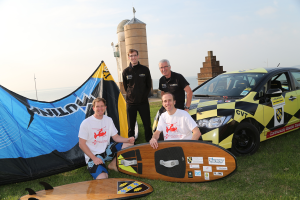3D printing has been used to make the extreme sport of windsurfing a bit more extreme in the lead up to a land vs. sea challenge this week. As five kite-surfers cross the Bristol Channel, competing against opponents racing to the same destination in a Japanese hybrid car, one person will be surfing on 3D printed parts.
As a part of the world’s first extreme sports engineering design course at the University of Wales, TSD Swansea, a team of designers was challenged to reconceptualize a kitesurfing board to beat out the University’s hybrid Honda Civic in a race across the Bristol Channel. The team, in conjunction with local Stratasys reseller Laser Lines, used two Stratasys Fortus 250mc 3D Production Systems to fabricate custom board fins with unique sizes, shapes, and angles to reduce the boards’ overall weight. The fins were then wrapped in carbon fiber for stiffness, while maintaining their lightweight and increasing the surfers’ speed. Along with the fins, the team 3D printed inserts for attaching straps to the board.
Product Design Manager for Cerebra at the University of Wales TSD Swansea, Ross Head, said of the event and the school’s program:
The use of 3D printing in product design, and especially in the extreme sport market, is revolutionising the manufacturing process and the speed to which companies can bring new products to market. We wanted our students to witness this first hand.
Stratasys 3D printing was essential to our ability to undertake this project at all. We would literally design, 3D print, fit and test the parts on the boards – all in one day. We would then tweak the designs as necessary and have another set of parts 3D printed overnight. The fact that we could 3D print end-use parts that could perform in the harsh sea environment, quicker and cheaper than any other manufacturing process, takes product development to a new and higher level for us.
We redesigned the boards’ fins using a quad configuration with parts 3D printed using PC-ABS. These new fins provide us with improved lateral grip in the water and the ability to make quick turns. On the underside of the boards, we also designed a very flat rocker line, which means that the boards plane easily and achieve much higher speeds. When you put all of these improvements together, they contribute towards considerable performance gains.
We are very excited about what 3D printing means for our industry and our course – essentially, anything our students can dream up can be made reality. I predict that 3D printing will play a huge role in the design and development of almost all final year projects for many years to come.
Marketing Manager for the UK, Scandinavia, Benelux at Stratasys, Simon Brandon, added, “We are seeing more and more educational establishments embrace 3D printing within the curriculum. This is a great example of a university equipping the engineers of the future with the skills to push the boundaries to new possibilities using Stratasys technology.”
The challenge will take place this week. It’s estimated that it will take about three hours for the surfers to cross the channel, but, in order to beat out the Civic, driving on country roads and in traffic, the surfers require a sea state of five or less with a wind speed of 20 knots. While the Swansea students did not participate in this initial design challenge, if it is a success, the university will initiate similar projects for students in the future.



